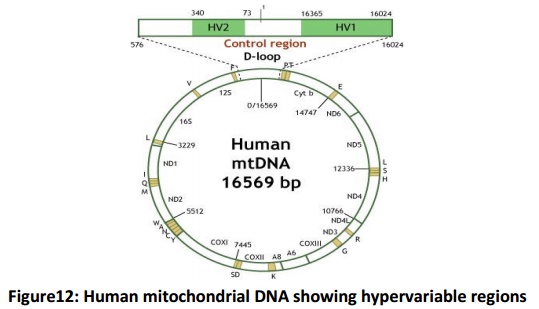Chapter: Basic Concept of Biotechnology : Biotechnology in Forensic Sciences
mtDNA in forensic science
mtDNA in forensic science
The examination of mitochondrial DNA is important for the identification of skeletal remains like teeth and bones. The average number of mtDNA molecules is 5000 in the epithelial cells, preferentially used in forensic case work. Due to this high copy number, it helps in better sensitivity for detection in cases where extremely small quantity of DNA or extremely degraded DNA is obtainable. Since, sperm mtDNA is degraded just after fertilization; the complete set of mitochondrial DNA in all the cells of all individuals is derived from mother. Due to this maternal inheritance, maternal family relationships can be determined bythe analysis of mtDNA even when a gap of several generations exists between a living person and an ancestor.
mtDNA testing may effectively progress the investigation and prosecution of cases with inadequate biological evidence, such as degraded skeletal remains and telogen hairs. mtDNA testing is also helpful in the area of post-conviction relief.
The most commonly used technique for regular forensic analysis of mtDNA is Sanger sequencing of two hypervariable regions (HVI andHVII) (Fig.12) within the control region (Displacement Loop, “D-loop”). It takes weeks to obtain reliable results. Other methods include minisequencing and the use of sequence-specific oligonucleotide probes and Pyrosequencing™ technology.
Forensic Applications
Mitochondrial DNA analysis is an appropriate method for:
§ Charred remains
§ Degraded specimens
§ Old skeletal and fingernail samples
§ Hair shafts

mtDNA is useful for the remains recovered from a missing person or in cases of mass disaster. The remains are found often in highly fragmented stage or only miniscule sample sizes are collected, such as a sliver of a bone or a single tooth. Biological material of known maternal relatives who are even quite distant could be used as reference sample for direct evaluation for the recovered remains. Next Generation Sequencing (NGS) can help in forensic testing to meet the challenges faced by mtDNA practitioners. Since, mixture interpretation is possible with this technology; NGS could broadenthe array of samples suitable for mtDNA analysis.
Other Applications
Scientists have used mtDNA analysis for medical studies, evolutionary studies, migration studies, genealogical studies, and historical identifications.
Related Topics